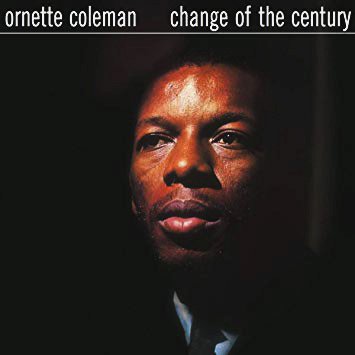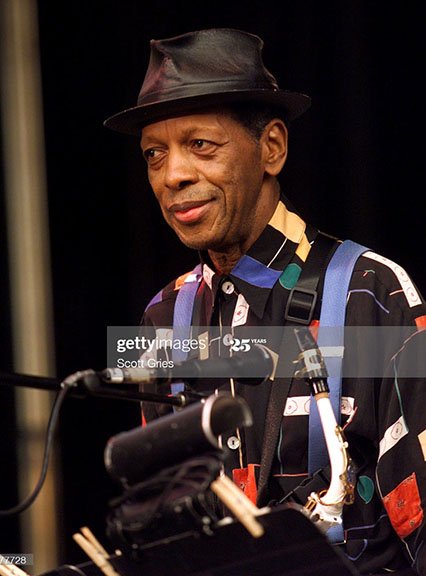Ramblin’
Ornette Coleman (saxo alto), Don Cherry (trompeta de bolsillo), Charlie Haden (contrabajo) y Billy Higgins (batería). Extraído del álbum Change of the Century (1960).
Este álbum era considerado por el gran cantante y guitarrista de rock Lou Reed como el mejor de todos los tiempos. Tras el extraordinario The Shape of Jazz to Come, el mundo del jazz esperaba con impaciencia a ver qué dirección tomaría el saxofonista alto Ornette Coleman. En Change of the Century profundizó aún más en su nuevo sonido y marcó la pauta a seguir para todo el jazz de vanguardia. En este segundo álbum de su mítico cuarteto, Coleman sigue los mismos pasos que en el anterior mostrando un grupo con cada vez con más confianza en su propuesta revolucionaria y en la comprenetración de sus miembros. Cuando Coleman se concentra en la melodía, sus temas son más atractivos, y cuando acentúa la interacción grupal, la improvisación es más libre. Los solos de Coleman son muy arriesgados y su estilo disonante transmite sin esfuerzo infinidad de emociones, mientras que su sección rítmica se vuelve cada vez más intuitiva.
This album was regarded by by the great rock singer and guitarist Lou Reed as the best ever. After the extraordinary The Shape of Jazz to Come, the jazz world eagerly awaited to see what direction alto saxophonist Ornette Coleman would take. On Change of the Century he went even deeper in his new sound and sets the standard for all avant-garde jazz to follow. In this second album by his legendary quartet, Coleman follows the same steps as the previous one, showing a group with more and more confidence in its revolutionary proposal and in the rapport of the members. When Coleman concentrates on the melody, his compositions are more attractive, and when he accentuates group interplay, improvisation is freer. Coleman’s solos are very adventurous and his dissonant style effortlessly conveys an infinite number of emotions, while his rhythm section becomes more and more intuitive.

Coleman a menudo era subestimado por no tener la misma técnica instrumental y el vocabulario armónico que sus predecesores, pero su excepcional sensibilidad y expresión estaba por encima de todo lo demás anunciando que el jazz nunca volvería a ser lo mismo. Tal vez por eso Change of the Century surgió con tanta urgencia y exuberancia, puesto que Coleman estaba liberando todas las ideas y emociones que habían sido restringidas por la tradición. Esa vitalidad convierte este álbum en una compra esencial en el punto de no retorno con el free jazz en el horizonte, y al igual que The Shape of Jazz to Come, en una de las grabaciones más destacadas de la carrera de Coleman, aunque el abandono de las estructuras de acordes y los patrones de tiempo convencionales es más pronunciado.
Coleman was often underrated for not having the same instrumental technique and harmonic vocabulary as his predecessors, but his exceptional sensitivity and expression was above all else, announcing that jazz would never be the same again. Maybe that’s why Change of the Century emerges with such urgency and exuberance, as Coleman was releasing all the ideas and emotions that had been restricted by tradition. That vitality turns this album into an essential purchase on the point of no return with free jazz on the horizon, and like The Shape of Jazz to Come, in one of the most outstanding records of Coleman’s career, even though the abandonment of conventional chord structures and time patterns is more pronounced.

Este es un tema funky con mucho swing que Coleman y Cherry tocan al unísono. Su melodía está llena de energía impetuosa. Coleman entra presentando de forma alegre y optimista frases inspiradas y convincentes mientras Haden introduce el walking en ciertos momentos. Le sigue Cherry, que despliega un discurso no tan entusiasta, pero bien concebido y elocuente. Next arrives Haden tocando con dobles notas un solo armónico y encantador. Lastly, el grupo reexpone el tema, Coleman y Cherry entran en un diálogo y al final repiten una frase del tema.
This is a funky, swinging theme that Coleman and Cherry play in unison. Its melody is full of blazing energy. Coleman comes in with a lively and optimistic rendition of inspired and convincing phrases while Haden introduces walking at certain times. He is followed by Cherry, who displays a speech not so enthusiastic, but well-conceived and eloquent. Next arrives Haden playing with double notes a harmonious and charming solo. Lastly, the group restates the theme, Coleman and Cherry enter into a dialogue and at the end they repeat a sentence of the theme.

Translated with the help of DeepL

Free
Ornette Coleman (saxo alto), Don Cherry (trompeta de bolsillo), Charlie Haden (contrabajo) y Billy Higgins (batería). Extraído del álbum Change of the Century (1960).
El tema lo tocan Coleman y Cherry al unísono y es tan divertido que podría haber sido compuesto para niños. A continuación el ritmo de la composición se vuelve mucho más rápido y enseguida Coleman interpreta un discurso intenso y complejo con multitud de cambios en una línea melódica acelerada y estimulante. Haden es sólido como una roca en todo momento y los acentos de Higgins son tan potentes como un huracán. Después, Cherry hace un solo intrincado y desenfrenado tocando como si no existiera el mañana, aunque a veces se modera un poco. Luego el grupo se mete en un breve pasaje de improvisación colectiva y Coleman se queda tocando unas cuantas frases más antes de la reexposición del tema.
The theme is played by Coleman and Cherry in unison and is so funny it could have been composed for children. Then the rhythm of the composition becomes much faster and at once Coleman offers an intense and complex discourse with many changes in an accelerated and stimulating melodic line. Haden is solid as a rock at all times and Higgins’ accents are as powerful as a hurricane. After that, Cherry makes an intricate and unrestrained solo playing as if there was no tomorrow, although sometimes moderates his pace a little. Next the group gets into a brief passage of collective improvisation and Coleman stays playing a few more phrases before the re-exposition of the theme.

℗ Atlantic Records


¡Enhorabuena!
✅ Has hecho un buen trabajo, por lo cual tu publicación ha sido valorada y ha recibido el apoyo de parte de CHESS BROTHERS ♔ 💪
♟ Te invitamos a usar nuestra etiqueta #chessbrothers y a que aprendas más sobre nosotros.
♟♟ También puedes contactarnos en nuestro servidor de Discord y promocionar allí tus publicaciones.
♟♟♟ Considera unirte a nuestro trail de curación para que trabajemos en equipo y recibas recompensas automáticamente.
♞♟ Echa un vistazo a nuestra cuenta @chessbrotherspro para que te informes sobre el proceso de curación llevado a diario por nuestro equipo.
🥇 Si quieres obtener ganancias con tu delegacion de HP y apoyar a nuestro proyecto, te invitamos a unirte al plan Master Investor. Aquí puedes aprender cómo hacerlo.
Cordialmente
El equipo de CHESS BROTHERS